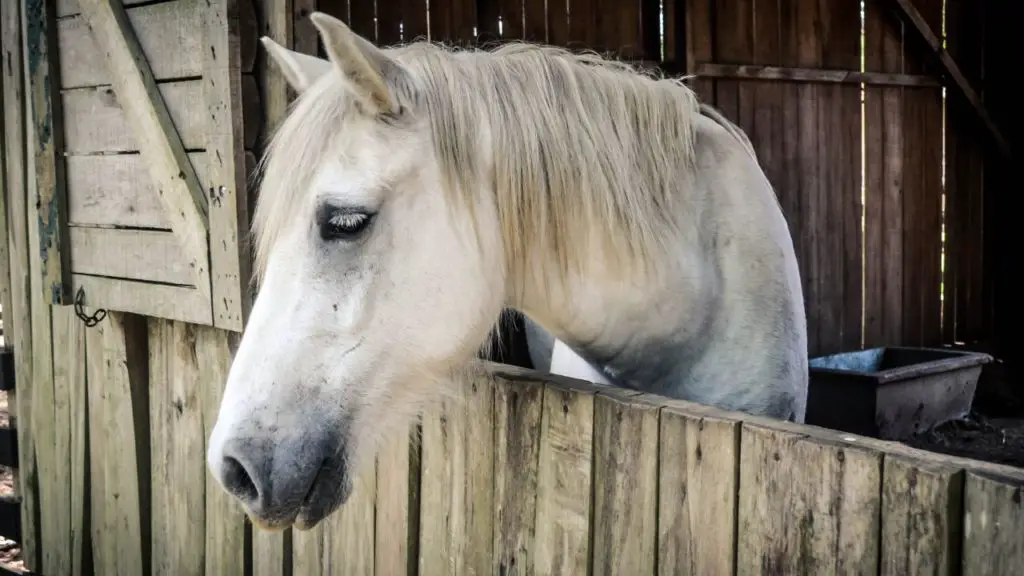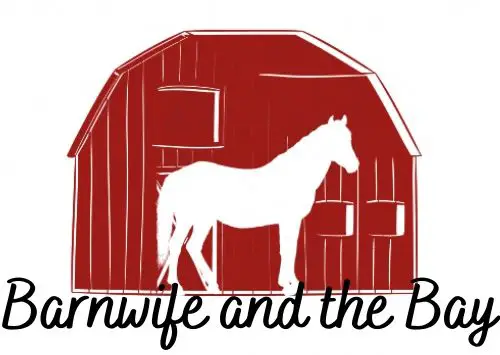
Boarding fees can vary a lot, based on a number of factors. The average cost to board a horse ranges from $200-$700. It can be as low as $100 or as high as $1,000 per month depending on the services and amenities provided by the boarding facility.
If you’re thinking about buying or adopting your first horse and wondering where to keep it, the options for horse boarding can be daunting.
Average cost to board a horse
Some boarding facilities provide extra services like training and lessons that are rolled into the cost of board.
For me, finding a boarding facility that fit my needs and my horse’s needs was difficult.
Now that I have my own property to keep my own horses, and board other people’s horses, I understand why the cost is what it is. I also understand why it can be so hard for horse owners to find the perfect boarding situation.
Let’s break down the different options for board, what’s included, and pros and cons of each.
Types of horse boarding and their average cost
Full care
Full care, or full board, is usually the most expensive type of board. The boarding stable takes on all of the daily care of your horse and provides all of the feed. Full care board sometimes comes with extra boarding services like deworming, scheduling and holding your horse for farrier appointments. Boarding costs for full board can range from $300-$700.
Pros of full care:
- Everything is included
- You get freedom to enjoy your horse without worrying about day-to-day care
Cons of full care:
- Most expensive
- You don’t get any first hand experience of horse care
Self care
Self-care board is at the low end of the spectrum of cost of horse boarding. You basically pay to rent space on someone else’s property, but you have to do all the work yourself. You also provide all your own feed and usually have to bring your own tools and implements too. Complete self-care board usually ranges from $100-$300 per month.
Pros of self care:
- You get first hand experience of caring for your horse
Cons of self care:
- Daily commute to the barn
- Time intensive
- Physically demanding
- Lack of scheduling freedom
Partial care
Partial care, or partial boarding, is an arrangement somewhere in between full care and self-care boarding. The boarding horses at my own barn are on a version of partial care.
I provide the hay, and most of the horse care on a daily basis. The owner provides their preferred feed concentrate. Owners also pick up barn chores on certain days.
Partial boarding arrangements can vary. Sometimes the owner is expected to provide their own feed, or bedding, or contribute in different ways to the work of the barn.
Another common arrangement is that the owner must allow their horse to be used for lessons or lease rides at the barn.
This is cheaper than full care, but more expensive than self-care. Partial care board can range in price from $150-$300 per month.
Pros of partial care:
- Cheaper than full care
- Still have a lot of freedom from daily horse care
Cons of partial care:
- Extra responsibility for barn chores or providing feed
Stall board
Stall board is a popular boarding option for horse owners that want their horse to be inside for at least part of every day.
Stall board is a term most often used in a full boarding situation where the horses are brought into a stall for the night, or during the day, or sometimes most of the time with limited turnout.
This is a popular option for those who go to horse shows frequently and need to make sure their horse won’t get injured or bitten in turnout.
Stall board at a full care facility can range from $300-$700 per month.
Pros of stall board:
- Peace of mind, knowing if there is bad weather, your horse will be in a stall.
Cons of stall board:
- Not appropriate for every horse
Pasture board
Pasture boarding is a great choice for horses that don’t need to be kept in a stall. Pasture board is usually referred to in the context of full-care board.
However, pasture board could be a type of self-care or partial care board as well.
It just means that your horse will be kept outside and will not have a stall in the barn.
Many horses thrive in a pasture board situation, as long as there is a shelter available in their enclosure.
Pasture board at a full-care facility is usually a bit cheaper than stall board, $150-$400 per month.
Pros of pasture board:
- Many horses thrive on 24/7 turnout
- Cheaper than stall board
Cons of pasture board:
- No stall in case of injury or really bad weather
Board and training
If your goal is to attend horse shows and be successful, board with training is a good choice. Board with training is usually full care board, and in addition a horse trainer works with your horse a set number of days per week.
Usually the horse is boarded at the trainer’s barn for a period of time. This usually costs between $500-$1,000 per month.
Pros of board with training:
- Your horse is taken care of and learns the skills you want them to have
Cons of board with training:
- More expensive than the other boarding options
What you get for your money when you board your horse
- A safe place for your horse to be turned out and get exercise (paddock or pasture)
- Shelter for your horse to live in (inside a stall or in the turnout area)
- Companionship for your horse
- Bedding if your horse is on stall board
- Feed if your horse is on full board
- Access to facilities (outdoor arena, indoor arena, tack room, wash rack, etc.)
- Someone to take care of your horse (feeding, watering, blanketing, turnout) on a daily basis
- Additional services like horse training
Why does boarding a horse cost so much
The high cost of horse boarding can be a bit shocking at first. Remember, the boarding business is most likely NOT making the kind of profit off of your horse that you might think. Here’s what your boarding fees might cover, depending on the facility:
- Hay
- Grain
- Bedding
- Water
- Electricity
- Fence repair/supplies
- Barn repair/supplies
- Arena maintenance
- Pasture seeding/maintenance
- Large farm equipment – tractors, mowers
- Small farm equipment – manure forks, wheelbarrows
- Gas for farm equipment
- Farm equipment repair/parts
- Full time barn staff or barn manager
- Part time barn staff
- Horse trainer/riding instructor time
- Food and veterinary care for barn cats
Factors that affect the price of board
Facilities and amenities – Better amenities like an indoor arena onsite, new barns, and tack rooms will raise the cost. Some barns have automatic sprayers in stalls for fly spray. Some have heated wash stalls. These all have the potential to raise the cost.
Land costs – Land costs vary by geograpical area. A stable owner must add enough to their boarding fees to be able to pay their mortgage.
Cost of water – The cost of water also varies by geographical area.
Location – Boarding in an urban area will be more expensive and scarce than boarding in a rural area.
Services – Extra services offered like blanket changes and grooming will add to the cost.
How to find a boarding facility
Finding a boarding facility to fit your needs can be difficult. Larger barns will have a website you can search for, but smaller barns probably won’t.
These smaller barns might be a great fit for the horse owner that doesn’t compete very much and doesn’t need too many extra amenities.
So how can you find them?
One of the best ways is to join a Facebook group for local horse people, and ask there for boarding opportunities.
Other places to find openings at smaller local barns are Craigslist and Facebook Marketplace.
Many barns will post fliers in local feed and tack stores. Proprietors of these equine stores are also likely to be members of the local equestrian community and may know of barns with boarding openings.
How to choose a boarding facility
A boarding barn will most likely have you sign a boarding contract before moving your horse in. It’s a good idea to check the contract carefully so there are no misunderstandings between you and the barn owner.
Things like additional cost for extra stall bedding or an additional fee for scheduling or holding your horse for vet visits should all be outlined in the contract.
If you’ve negotiated a cheaper rate in exchange for doing some barn chores or stall cleaning, that should be explicitly stated in the contract.
Try to visit the barn to see for yourself that each horse’s daily needs are being met and the facility is satisfactory.
At the least there should be a safe place for turnout that accommodates the number of horses in the herd.
Make sure there are clean water troughs or automatic waterers in all turnout areas and stalls.
Daily hay must be appropriate for the needs of the horses. That means each horse has access to at least 2% of its body weight in forage daily.
Check for clean stalls if you’re considering stall board.
Each barn has a different number of boarders. Find out the herd size, and think about whether it will be appropriate for your horse.
In general, horses love to have lots of friends. But some horses do better in smaller herds.
The atmosphere of the barn is also a factor to think about. Some horses don’t thrive in large bustling show barns, while some do fine with that increased level of excitement.
Consider whether the boarding operation has a horse trainer or riding instructor onsite if you want to increase your riding skills. If they do not have a trainer onsite, make sure the barn owner is ok with you bringing in an outside trainer to help you and your horse.
FAQ
Is it cheaper to board a horse or keep it at home?
It is usually cheaper to keep a horse at home than to board it. But there are many expensive aspects to keeping a horse at home as well. For detailed information about the costs involved with keeping horses at home, check out my comprehensive articles on the cost of keeping horses at home and the stuff you need to keep horses at home.
Can you make money off boarding horses?
Most boarding barns don’t make very much profit. In my experience, unless you have a large barn with lots of boarders, you will find it difficult to do much more than break even. Most large barns offer lessons as well as boarding horses, and that’s how they make a profit.
How much does it cost to feed a horse a week?
The cost to feed a horse for a week varies by region, and depends on the horse’s diet and the price of hay. It can range from $15-$80. It costs me about $37 per week to feed The Bay.
Like this post? Jump into these related posts:
